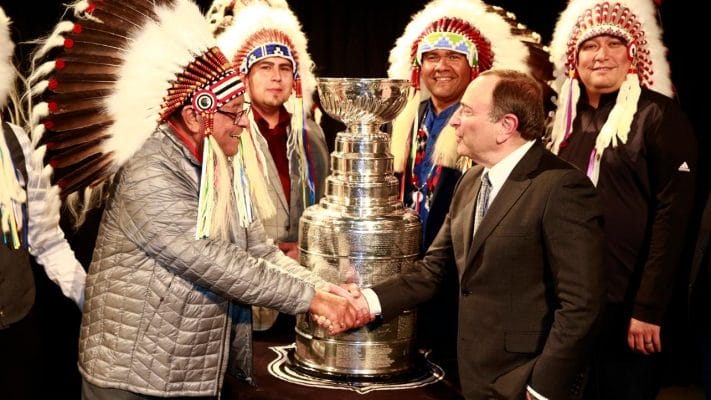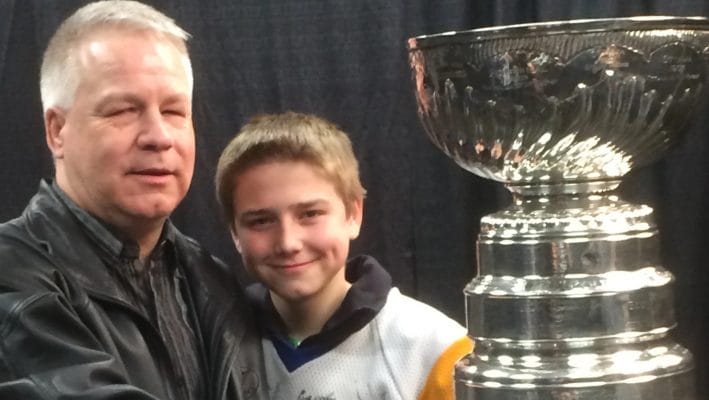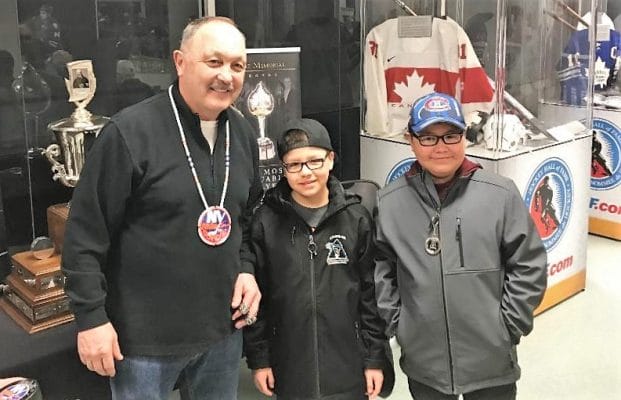Finding Heroes – Fred and Georgie – and a place to feel comfortable
By Eugene Arcand

Residential school took away so much from me, but it was there, at Duck Lake as a small boy, I found my heroes.
I remember being only seven or eight years old when I saw a film about Jim Thorpe and the Carlisle Indian School (in Carlisle, Penn.) that Thorpe attended before going on to become an Olympian and one of the greatest athletes in the world. He was a hero to me.
Another one of my heroes was Gordie Howe. I remember being at St. Michael’s and on Saturday night we would all sit around and watch Hockey Night in Canada on this little black and white TV. All the kids would cheer for the Toronto Maple Leafs or Montreal Canadiens, but I didn’t like either one of those teams.
I heard the commentators talking about this young hockey player from Saskatoon, Sask., on the Detroit Red Wings and his name was Gordie Howe. I knew nothing about him, but from that moment forward, because he was from Saskatoon, he was a hero to me. Years later, when I got to see Gordie play, I loved him even more because he played hockey the way I wanted to play the game.

My No. 1 hero was Fred Sasakamoose, a Cree hockey player from the Ahtahkakoop Cree Nation. I actually had heard stories about Fred at home at a very young age, before I went to St. Michael’s, from my grandparents.
When I arrived at Duck Lake, I learned that Fred had attended St. Michael’s before me and learned to play hockey there. He went on to play for the Chicago Blackhawks in the 1953-54 season and become the first First Nations (with treaty status) player in the NHL. We heard all about his great athletic accomplishments – not only his hockey exploits, but also in soccer and his incredible speed in track and field. When he was a little guy, they said nobody could catch him – on the ice or the field or the track. Freddy became my hero from those stories.
It’s still amazing to me that I not only got to meet my heroes, both Gordie and Fred, but become close with them, especially Fred.
I’ll never forget the first time I met Fred. I was probably 16 or 17 years old, towards the end of my time in residential school, and it was Easter break. There was a big Indian tourney in North Battleford — in its heyday it was the Stanley Cup of Indian hockey. I was injured and up in the stands watching my team play. My buddy was carrying the puck up the ice and there was a guy in the stands who said, Who’s that guy? He’s a helluva skater.
I asked someone, Who is that guy [asking the question]?
and they said, That’s Fred Sasakamoose.

I made my way over to him. He said to me, You play hockey?
I said, Yeah, with these guys on the ice.
Why aren’t you out there?
he asked me.
I’m injured,
I told him. My knee is banged up.
Fred looked at me and I’ll never forget what he said: Long way from the heart, kid.
That’s what he said to me. I adopted that. For the rest of the time I played hockey, I was never carried off the ice. I always skated off. No matter how hurt I was, how beaten up I was, I’d get myself off the ice.
That was my first experience with Fred. I didn’t get to know him better until years later. I got to see him play some games in his later years in Saskatchewan. We worked together to promote sports, recreation and culture for Indigenous kids. And we became close friends.
Fred making the NHL was an amazing accomplishment. The fact he played a small number of games (11) in the NHL has been trivialized recently. Anyone who would do that, well, they have no idea. There were only 120 players in the six-team league at that time. For anyone to make it, even for one game, is unbelievable.

But for Freddie to have been in a residential school and go through everything he had to deal with in his life, to get to The Show, even for a cup of coffee…Freddie went through hell to be the MVP of the Western Hockey League; he went through hell to get to the NHL. Most people have no idea. And I don’t know what happened, why Freddie didn’t play more games, but something happened.
When Fred went to Chicago in November of 2002 to be honoured by the Blackhawks, he asked me to go along with him. I’ve never talked publicly about what I heard and saw that day.
We were in owner Bill Wirtz’s office. His son, William Wirtz Jr., was there, too. William Jr. had given us a nice tour of the United Centre. And there was another person in the office, a little old man with white hair. I don’t know his name. This man whispered something to Bill Wirtz. Then Bill whispered something to his son. I don’t know what was said, but the little old man with white hair, and I could hear him, said: Come on Bill, you know damn well that what happened to Freddie here was not right.
Bill Wirtz then opened up his desk drawer and pulled out a small square box. He opened it up and it was this large fine-cut diamond with the Blackhawks’ logo on top of it, celebrating the franchise’s 75th anniversary. He gave that box to Fred. The little old man with the white hair then said to Fred, Only 75 of those were ever made.
I later asked Fred about what the man had said in the office, about something that happened to him. A couple of times actually, but Fred would just shake his head and say nothing. He didn’t want to talk about it. But something happened.
Fred died in hospital on Nov. 24, 2020, after getting COVID. He was 86. He was such an inspiration to our people, not only for making it to the NHL but for all he did after that. He worked with young people, promoting sport, in our communities. He was a band counselor and Chief of the Ahtahkakoop. He testified about his time at a residential school to the Truth and Reconciliation Committee. He was my friend; he was my hero.
The first time I met Gordie Howe was thanks to my friend Gerry Nelson, who is one of the top blind golfers in the world. When I was in North Battleford, I got to know Gerry. He was a rare cat, a little blonde Settler guy who liked hanging out with Indigenous people. Before he lost his sight because of diabetes, we played hockey and ball and hung out whenever we could. His nickname with us with is Sniveler.
You might have heard of Gerry and his son Wyatt. In 2016, their story got national coverage because Wyatt would do play-by-play for his dad while sitting beside Gerry at Saskatoon Blades games. The St. Louis Blues invited them to an NHL game. They got to spend time with the Stanley Cup and Wyatt did some play-by-play for his dad on the Blues’ radio broadcast of that game.

So, Gerry invited me to play in a Canadian National Institute for the Blind (CNIB) fundraising golf tourney in Saskatoon and Gordie Howe was there as an ambassador for the CNIB. Gordie was at the 10th hole, signing autographs and getting his picture taken. Gerry and Gordie already knew each other. Gerry introduced me to Gordie, and I told Gordie he was one of two heroes in my life, Fred Sasakamoose being the other.
Gordie looked me in the eye and told me it was an honour to meet me. He had no idea who he was talking to, but I knew who I was talking to. A few minutes later, we had to line up for pictures. Just before the first picture was being taken, I said to Gerry, Sniv, I know you’re blind but you’re facing the wrong way.
So, I turned him around. Gordie is looking at me like, What the hell are you doing?
So, with Gerry now facing the wrong way, we took the picture. I turned Sniv back around, we all had a good laugh and then took a proper picture. Gordie was shaking his head, he said to me, You’re a real character, aren’t you?
That was the beginning of a friendship. We met up at the banquet after the golf and spent some time together.
We would run into each other over the course of a number of years, the last of which was at former NHL players Garry Peters’ and Rich Pilon’s charity golf tourney. Gordie was so tickled at us playing a joke on our blind friend that he always remembered me. It was a really hot day and Gordie was at that age when he was starting to need some help with things, so his son, Marty, was with him.
When we got to the tee box where Gordie and Marty were, Marty mentioned what a nice day it would be if they were golfing instead of standing around in the hot sun. I jumped right on that: Well, Marty, I got a good set of clubs here. Why don’t you jump on the cart and finish the round? I’ll sit with your Dad.
So, Gordie and I spent the afternoon together. It was a dream for me. A few hours with Gordie. When hockey people get together, not a lot has to be said. It just feels good. He felt good with me there and I felt good with him there. We shared some funny things, but I also shared some stories from my life, and he shared some of his stories, too.
One of the things that Gordie said to me that day was, Freddy [Sasakamoose] didn’t get a fair shake in Chicago.
That stayed with me for the rest of time. And that was the second time someone who knew about Fred’s time in Chicago had mentioned something happening. For Gordie to say that about Freddy, it really meant something. Gordie had the longest career in hockey, but he knew all about Freddy’s short career. And how relevant was it for my two heroes to be connected like that?

I can also thank hockey for giving me my nickname: Big Bird. Which then got shortened to Bird.
I was playing in a tourney at Onion Lake on the Alberta/Saskatchewan border when I was around 20 years old. I always wore No. 14. We were playing the Lloydminster Border Chiefs in Seekaskootch Arena and my nemesis on that team was a little fireplug, the late Randy Whitestone. My job was to slow him down. He was a local favourite. If you touched him, the crowd would go nuts. I would go after him hard.
There was a break in the action and there was this lady, the late Anna Crowe, who was Randy’s auntie. So, she stands up and yells at me: No. 14, you asshole! I hate you, you big…
She paused, maybe because she realized everyone was looking at her or maybe she didn’t want to swear again. And then she said: You big bird!
All the fans laughed. That was the start of my nickname and it stuck.
I always say hockey is a small world. I love being around hockey people, just talking and sharing stories. I remember one sports dinner at the Dakota Dunes Casino where Bryan Trottier, Bob Bourne and Clark Gillies made an appearance.

They asked Trots who he wanted to look after them, to host them at the dinner, and he said, Big Bird.
Trots and I knew each other from some Indigenous events. Clark Gillies and Bobby Bourne were both Saskatchewan guys who played junior in Regina and Saskatoon.
The night of the banquet, there was an autograph session. There was a long lineup to get their autographs. A Settler wearing a farmer’s cap came up to me and shook my hand. How you doing, Big Bird?
I couldn’t place him. He seemed to know me so well. He didn’t get in the autograph line, but he kept asking me to get him to the front to get autographs and pictures with the players.
After the banquet is over, there’s a lineup to talk to the players. This farmer guy is about tenth in line. He calls me over and says, Big Bird, get me up there. You’re the guy here. Make it happen.
I told him, Relax, partner. You’ll get your shot.
He kept bugging me and I finally got fed up and told him to wait his turn and that everyone else is waiting, too. And then I said, Besides, I don’t even know you.
He said, You don’t remember me? Well, maybe you will remember this,
and he took off his hat. I suddenly remembered who he was. So, I said, Come with me, my friend.
I didn’t know his name but now I knew who he was. So, I get him up there with the players and he rats me out to Trots, Gillies and Bourne. You see this scar on my head?
he asked them, Big Bird did this to me and I wasn’t even on the ice.
It’s a pretty funny story.

Back in the day, I was playing for the intermediate Blues in a game at Unity. There was no plexiglass back then; it was all chicken wire. I went into the corner, got turned around and got hit a couple of times. My stick went through the chicken wire into the stands and a Settler fan grabs my stick.
Play goes down the ice, but he won’t let go of my stick and he’s really putting on a show. All the other Settlers are laughing. I realized brawn was not going to work because he was not going to let go. He was enjoying his celebrity too much. Finally, I said, C’mon buddy, let my stick go. I gotta get down the ice.
Surprisingly, he lets go. As soon as he did, I conked him over the head and took off down the ice.
The next shift I come out and there’s a first-aid person there and they’re patching up his forehead. He’s leaking pretty bad. And they left a big chunk of cotton batting taped on his forehead. So, I see this, I point at him and start laughing. That made all the other Settlers laugh. He’s mad as hell but he can’t do anything about it. So, I kept it going the whole game. I would skate down the ice with the puck and make-believe I was going to shoot it at him. And that made the fans go even more crazy. Then he would go crazy.
Well, fair to say Trots, Clark and Bobby loved that story.
There aren’t many spaces in this world where I feel truly comfortable. Being with my people, fellow survivors, is definitely the most important one, but being with hockey people is another.
